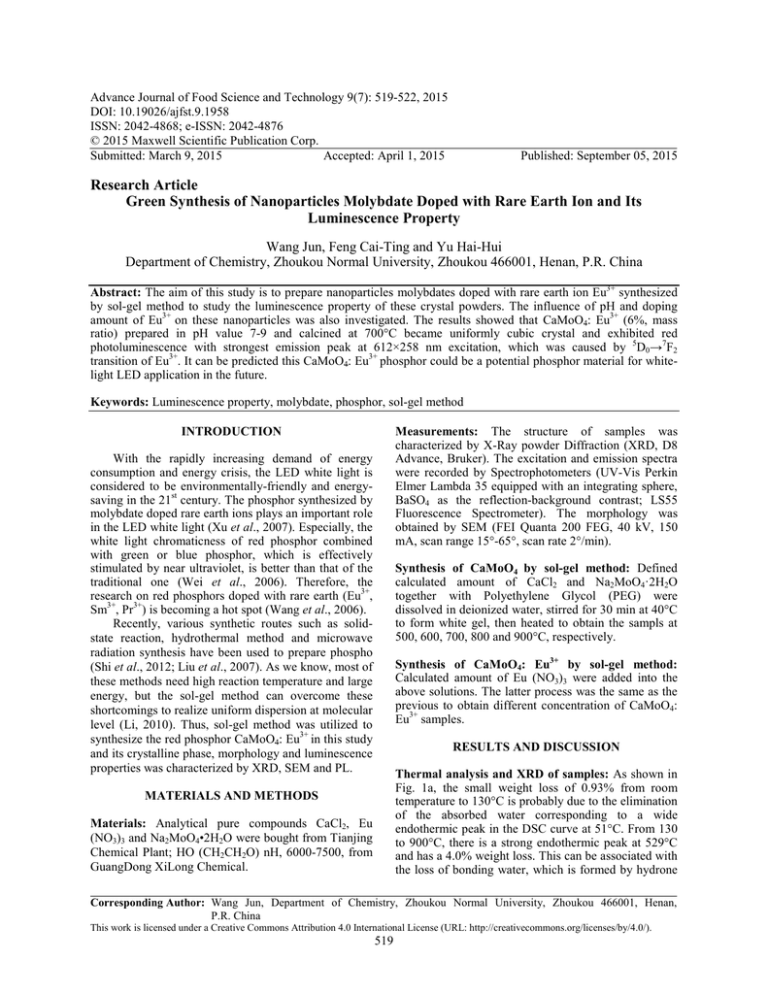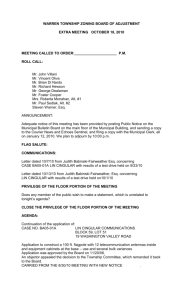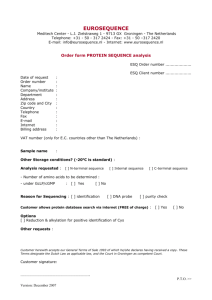Advance Journal of Food Science and Technology 9(7): 519-522, 2015
advertisement

Advance Journal of Food Science and Technology 9(7): 519-522, 2015 DOI: 10.19026/ajfst.9.1958 ISSN: 2042-4868; e-ISSN: 2042-4876 © 2015 Maxwell Scientific Publication Corp. Submitted: March 9, 2015 Accepted: April 1, 2015 Published: September 05, 2015 Research Article Green Synthesis of Nanoparticles Molybdate Doped with Rare Earth Ion and Its Luminescence Property Wang Jun, Feng Cai-Ting and Yu Hai-Hui Department of Chemistry, Zhoukou Normal University, Zhoukou 466001, Henan, P.R. China Abstract: The aim of this study is to prepare nanoparticles molybdates doped with rare earth ion Eu3+ synthesized by sol-gel method to study the luminescence property of these crystal powders. The influence of pH and doping amount of Eu3+ on these nanoparticles was also investigated. The results showed that CaMoO4: Eu3+ (6%, mass ratio) prepared in pH value 7-9 and calcined at 700°C became uniformly cubic crystal and exhibited red photoluminescence with strongest emission peak at 612×258 nm excitation, which was caused by 5D0→7F2 transition of Eu3+. It can be predicted this CaMoO4: Eu3+ phosphor could be a potential phosphor material for whitelight LED application in the future. Keywords: Luminescence property, molybdate, phosphor, sol-gel method Measurements: The structure of samples was characterized by X-Ray powder Diffraction (XRD, D8 Advance, Bruker). The excitation and emission spectra were recorded by Spectrophotometers (UV-Vis Perkin Elmer Lambda 35 equipped with an integrating sphere, BaSO4 as the reflection-background contrast; LS55 Fluorescence Spectrometer). The morphology was obtained by SEM (FEI Quanta 200 FEG, 40 kV, 150 mA, scan range 15°-65°, scan rate 2°/min). INTRODUCTION With the rapidly increasing demand of energy consumption and energy crisis, the LED white light is considered to be environmentally-friendly and energysaving in the 21st century. The phosphor synthesized by molybdate doped rare earth ions plays an important role in the LED white light (Xu et al., 2007). Especially, the white light chromaticness of red phosphor combined with green or blue phosphor, which is effectively stimulated by near ultraviolet, is better than that of the traditional one (Wei et al., 2006). Therefore, the research on red phosphors doped with rare earth (Eu3+, Sm3+, Pr3+) is becoming a hot spot (Wang et al., 2006). Recently, various synthetic routes such as solidstate reaction, hydrothermal method and microwave radiation synthesis have been used to prepare phospho (Shi et al., 2012; Liu et al., 2007). As we know, most of these methods need high reaction temperature and large energy, but the sol-gel method can overcome these shortcomings to realize uniform dispersion at molecular level (Li, 2010). Thus, sol-gel method was utilized to synthesize the red phosphor CaMoO4: Eu3+ in this study and its crystalline phase, morphology and luminescence properties was characterized by XRD, SEM and PL. Synthesis of CaMoO4 by sol-gel method: Defined calculated amount of CaCl2 and Na2MoO4·2H2O together with Polyethylene Glycol (PEG) were dissolved in deionized water, stirred for 30 min at 40°C to form white gel, then heated to obtain the sampls at 500, 600, 700, 800 and 900°C, respectively. Synthesis of CaMoO4: Eu3+ by sol-gel method: Calculated amount of Eu (NO3)3 were added into the above solutions. The latter process was the same as the previous to obtain different concentration of CaMoO4: Eu3+ samples. RESULTS AND DISCUSSION Thermal analysis and XRD of samples: As shown in Fig. 1a, the small weight loss of 0.93% from room temperature to 130°C is probably due to the elimination of the absorbed water corresponding to a wide endothermic peak in the DSC curve at 51°C. From 130 to 900°C, there is a strong endothermic peak at 529°C and has a 4.0% weight loss. This can be associated with the loss of bonding water, which is formed by hydrone MATERIALS AND METHODS Materials: Analytical pure compounds CaCl2, Eu (NO3)3 and Na2MoO4•2H2O were bought from Tianjing Chemical Plant; HO (CH2CH2O) nH, 6000-7500, from GuangDong XiLong Chemical. Corresponding Author: Wang Jun, Department of Chemistry, Zhoukou Normal University, Zhoukou 466001, Henan, P.R. China This work is licensed under a Creative Commons Attribution 4.0 International License (URL: http://creativecommons.org/licenses/by/4.0/). 519 Adv. J. Food Sci. Technol., 9(7): 519-522, 2015 Fig. 1: TG-DSC curve of CaMoO4; (a): No addition PEG; (b): Addition PEG (a) (b) Fig. 2: XRD patterns of the CaMoO4 samples (addition PEG) obtained at; (a): Different firing temperature; (b): Different PH value and the component of CaMoO4 and residual hydroxyl. When the reaction system is added PEG (Fig. 1b), the weight loss of 1.1% from room temperature to 122°C is also attributed to the elimination of the absorbed water, corresponding to a wide endothermic peak in the DSC curve at 44°C. As present in the figure, there are two small endothermic peaks at 523 and 648°C and the weight loss is about 4.3%. These results suggest that CaMoO4 is basically stable at 500°C, so we select the temperature of 500, 600, 700, 800 and 900°C, respectively to calcine. Figure 2a shows the XRD patterns of as-prepared samples. The position and intensity of diffraction peaks are basically unanimous at 500, 600 and 700°C, respectively indicating that the phase is stable at this temperature range. When the temperature is 800°C, the position and intensity of diffraction peaks of the sample are the same as that of 500-700°C. However, the peaks of the sample become to change at 800°C, which indicates that it might be a new phase. The diffraction peaks at 900°C are different from the peaks at 500700°C. It can be speculated that it is a new phase or another substance. The appropriate temperature of synthesis CaMoO4 is in the range of 500-700°C. According to Fig. 2b, when the PH value of solution ranges from 7 to 11, products will quickly generate. The XRD patterns of the products are successively consistent with the standard map when PH value between 7-9. Photoluminescence properties of samples: The CaMoO4: Eu3+ red phosphor can be stimulated at 223, 258 and 283 nm, respectively which are the same as the wavelength of LED chip (Fig. 3a). So this phosphor can be used as red phosphor of LED white light. The main peak at 612 nm corresponds to 5D0-7F2 electric dipole transition of Eu3+. The intensity of light is different accompanied by the different amount of doping Eu3+ under the excitation of 258 nm (Fig. 3b). When the doping content is from 2 to 6%, the intensity is becoming stronger as increasing content, while it is strongest at 6% Eu3+. But the intensity becomes weaker while the content is more than 6% because of the concentration quenching phenomenon. 520 Adv. J. Food Sci. Technol., 9(7): 519-522, 2015 Fig. 3: Excitation spectrum of CaMoO4: Eu3+ with different amount of Eu3+ doping under 258 nm excitation Fig. 4: SEM images of CaMoO4; (a, b): Fired at 500 and 700°C, respectively (no addition PEG); (c, d): CaMoO4 and CaMoO4: Eu3+ (5%) fired at 700°C (addition PEG) Morphology characterization of samples: In Fig. 4a, the SEM image of CaMoO4 prepared at 500°C with no PEG in the synthesis process shows a number of agglomerated particles and the size of particles is basically uniform. When CaMoO4 prepared at 700°C, these particles are rarely agglomerated and the size is also uniform (Fig. 4b). However, when PEG is in added in the prepared process, the particles become agglomerated (Fig. 4c). In Fig. 4d the CaMoO4: Eu3+ (5%) prepared at 700°C with PEG in the synthesis process shows uniformly cubic crystal. by TG-DSC, XRD, SEM and PL spectra. The thermal analysis and the XRD results indicates that the powder calcined at 700°C can be obtained pure phase and the phase might change at higher temperature. The CaMoO4: Eu3+ can be emitted red light at 223, 258 and 283 nm, respectively by ultraviolet light and the maximum emission peak is 612 nm, which coincide with the emitting light of near ultraviolet and blue LED chips. When 6% Eu3+ is added, the intensity of light becomes strongest among the reported content. ACKNOWLEDGMENT CONCLUSION This study is supported by the Program for Science and Technology Research Projects of Henan Province (No. 142300410353). In this study, we prepared CaMoO4: Eu3+ red phosphors by sol-gel method, which was characterize 521 Adv. J. Food Sci. Technol., 9(7): 519-522, 2015 Wang, X., J. Zhuang, Q. Peng and Y.D. Li, 2006. Hydrothermal synthesis of rare-earth fluoride nanocrysals. [J]. Inorg. Chem., 45(17): 6661-6667. Wei, X.W., J. Xu, X.J. Song, Y.H. Ni, P. Zhang, C.J. Xia, G.C. Zhao and Z.S. Yang, 2006. Multiwalled carbon nanotubes coated with rare earth fluoride EuFB3B and TbFB3B nanoparticles [J]. Mater. Res. Bull., 41: 92-99. Xu, X.D., G.Z. Xu, Z.C. Wu et al., 2007. Research progress on phosphors for white light-emitting diodes [J]. Acta Sci. Naturalium Univ., Sunyatseni, 46(5): 124-128. REFERENCES Li, H.B., 2010. Study on luminescent properties of the red phosphor NaEu (MoO4)2 prepared via solgel process [J]. Liaoning Chem. Ind., 39(10): 1010-1013. Liu, J., H.Z. Lian and C.S. Shi, 2007. Improved optical photoluminescence by charge compensation in the phosphor system CaMoO4: Eu3+ [J]. Opt. Mater., 29(12): 1591-1594. Shi, W.J., X.L. Zhang, C.Y. Li et al., 2012. Synthesis and luminescent properties of NaAlSiO4:Eu3+ phosphors using coal fly ash as starting materials [J]. J. Chinese Rare Earth Soc., 30(3): 315-319. 522


